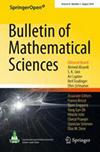虚二次数环中丢番图m元组的大小
IF 2.5
2区 数学
Q1 MATHEMATICS
引用次数: 10
摘要
丢番图[公式:见文本]元组是一组不同的整数,使得任意两个不同的元素加一的乘积是完全平方。最近证明了在正整数中不存在丢番图五元组。我们在虚二次域的整数环上研究了同样的问题。通过使用由丢番图近似证明的间隙原理,我们表明[公式:见文本]。与正整数中类似结果的证明相比,我们的证明相对简单。本文章由计算机程序翻译,如有差异,请以英文原文为准。
On the size of Diophantine m-tuples in imaginary quadratic number rings
A Diophantine [Formula: see text]-tuple is a set of [Formula: see text] distinct integers such that the product of any two distinct elements plus one is a perfect square. It was recently proven that there is no Diophantine quintuple in positive integers. We study the same problem in the rings of integers of imaginary quadratic fields. By using a gap principle proven by Diophantine approximations, we show that [Formula: see text]. Our proof is relatively simple compared to the proofs of similar results in positive integers.
求助全文
通过发布文献求助,成功后即可免费获取论文全文。
去求助
来源期刊

Bulletin of Mathematical Sciences
MATHEMATICS-
CiteScore
2.10
自引率
0.00%
发文量
17
审稿时长
13 weeks
期刊介绍:
The Bulletin of Mathematical Sciences, a peer-reviewed, open access journal, will publish original research work of highest quality and of broad interest in all branches of mathematical sciences. The Bulletin will publish well-written expository articles (40-50 pages) of exceptional value giving the latest state of the art on a specific topic, and short articles (up to 15 pages) containing significant results of wider interest. Most of the expository articles will be invited.
The Bulletin of Mathematical Sciences is launched by King Abdulaziz University, Jeddah, Saudi Arabia.
 求助内容:
求助内容: 应助结果提醒方式:
应助结果提醒方式:


